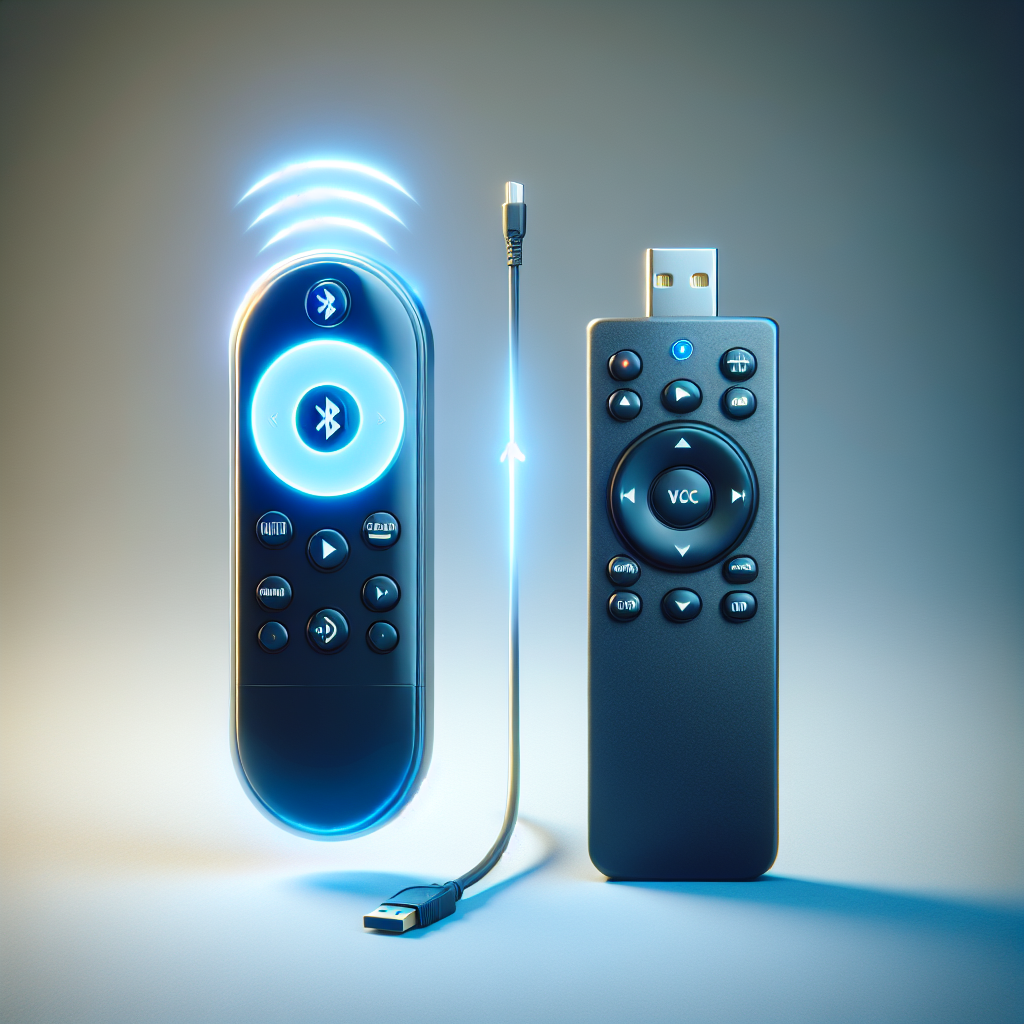Introduction
Remote controls have become indispensable in our daily lives, offering convenience and ease of use for a variety of devices. With the advancement of technology, remotes have evolved significantly, primarily into two categories: Bluetooth and wired. This article provides an in-depth comparison between Bluetooth and wired remotes, highlighting their features, advantages, disadvantages, and specific use cases, to help you make an informed decision.
Understanding the Basics
What are Bluetooth Remotes?
Bluetooth remotes utilize wireless technology to communicate with devices. They operate using a short-range radio frequency, typically in the 2.4 GHz band, allowing them to connect to devices without the need for physical cables. Bluetooth technology is known for its ability to connect multiple devices, making it a versatile option for a range of applications from audio equipment to smart home devices.
What are Wired Remotes?
Wired remotes, as the name suggests, connect to devices using a physical cable. They typically use a USB or auxiliary cable to establish a connection. Wired remotes have been around for much longer than their Bluetooth counterparts and are often found in devices where a stable and uninterrupted connection is crucial, such as professional audio and video equipment.
Performance Comparison
Connectivity and Range
Bluetooth remotes offer the advantage of wireless connectivity, allowing users to control devices from a distance without the hassle of cables. The typical range for Bluetooth connectivity is around 10 meters (33 feet), though some advanced versions can reach up to 100 meters (328 feet) in open spaces. This makes Bluetooth remotes ideal for controlling devices in larger rooms or even across different areas of a home.
- 【Kit Four Great Lense in One】: Impresionante fotografía móvil para la mayoría de los teléfonos inteligentes. Incluye 4 lentes: teleobjetivo 18x, lente ojo de pez, gran angular y macro. Todas...
- 【Fotografía mejorada】: el teleobjetivo 18x puede obtener una toma clara de sujetos que generalmente están demasiado lejos para capturarlos. También es un lente monocular con teleobjetivo con...
- Transmisión bidireccional: el lector de tarjetas SD para iPhone/iPad admite la transferencia bidireccional de tarjeta SD a iPhone o iPhone/iPad a tarjetas de memoria SD.
- Plug and Play: el lector de tarjetas SD no requiere aplicaciones de terceros, utiliza la aplicación de archivos integrada en iOS y admite la reproducción de vídeo.
Wired remotes, on the other hand, are limited by the length of their cables. While this ensures a stable connection, it can also restrict mobility and usage range. In environments where the user needs to be close to the device or where wireless signals are unreliable, wired remotes are often preferred.
Latency and Responsiveness
One of the critical performance aspects of any remote control is latency, which refers to the delay between pressing a button and the device responding. Bluetooth remotes may experience slight latency due to wireless transmission, which can be noticeable in high-precision applications. However, advancements in Bluetooth technology have significantly reduced this delay, making it negligible for most consumer applications.
Wired remotes have near-zero latency since the signal is transmitted directly via a cable. This makes them ideal for professional settings such as music production or video editing, where immediate response is crucial.
Power and Battery Life
Bluetooth Remotes
Bluetooth remotes are powered by batteries, which can be either rechargeable or replaceable. The battery life of a Bluetooth remote varies based on usage and the type of battery used. Some models can last several months on a single charge, while others may require more frequent charging. The advantage of Bluetooth remotes is their portability, as they can be used without being tethered to a power source.
Wired Remotes
Wired remotes do not require batteries, as they draw power directly from the connected device. This eliminates the need for battery maintenance and ensures that the remote is always ready for use as long as it is plugged in. However, this also means that the remote’s mobility is limited by the cable length and availability of a power source.
Durability and Maintenance
Bluetooth Remotes
Bluetooth remotes are generally designed to be robust and portable, but they are not immune to wear and tear. The primary maintenance concern is battery replacement or recharging. Additionally, Bluetooth remotes can be affected by interference from other wireless devices, although this is less of an issue with modern Bluetooth standards.
Wired Remotes
Wired remotes tend to be more durable due to their simple construction and lack of a battery. However, the cables can be a point of failure, particularly if they are frequently bent or twisted. Regular inspection of cables and connectors is recommended to ensure reliable performance.
Compatibility and Versatility
Bluetooth Remotes
One of the significant advantages of Bluetooth remotes is their compatibility with a wide range of devices. Most modern devices, including smartphones, tablets, and computers, come with built-in Bluetooth capability, making it easy to pair and control them with a Bluetooth remote. This versatility makes Bluetooth remotes an attractive option for users who want to control multiple devices with a single remote.
Wired Remotes
Wired remotes are sometimes limited by the type of connection they use. For instance, a remote with a USB connection cannot be used with a device that only has an auxiliary input. This can limit the versatility of wired remotes, although adapters and converters are available to bridge compatibility gaps. Wired remotes are typically found in specialized applications where compatibility with specific devices is ensured.
Cost Considerations
The cost of remotes can vary widely based on features, brand, and technology. Bluetooth remotes are generally more expensive than their wired counterparts due to the added technology and flexibility they offer. However, they represent a good investment for users seeking convenience and versatility. Wired remotes, being simpler in design, are usually more affordable, making them a cost-effective choice for users who require a reliable connection without the need for wireless features.
Security and Interference
Bluetooth Remotes
Security is a crucial consideration with Bluetooth remotes, as they use wireless communication, which could potentially be intercepted. Modern Bluetooth standards incorporate encryption to safeguard data transmissions, minimizing the risk of unauthorized access. However, users should always ensure their devices use the latest Bluetooth security protocols.
Interference from other wireless devices can occasionally affect Bluetooth remotes, but advanced Bluetooth versions have improved interference resistance.
Wired Remotes
Wired remotes offer a more secure connection as they do not rely on wireless transmission. This makes them immune to issues like signal interception and interference from other wireless devices. The direct connection of wired remotes ensures a stable and secure control mechanism, particularly important in professional and industrial environments.
Conclusion
Choosing between Bluetooth and wired remotes depends largely on the specific needs and preferences of the user. Bluetooth remotes offer the convenience of wireless operation, versatility, and the ability to control multiple devices from a distance. They are ideal for everyday consumer use, home automation, and scenarios where portability is a priority.
Wired remotes, with their reliable and stable connection, are best suited for professional settings, environments where latency is critical, or locations where wireless signals might be unreliable. They provide a cost-effective solution and eliminate concerns related to battery life and wireless interference.
Ultimately, the decision should be based on the intended use, required features, and budget. Understanding the strengths and limitations of each type of remote will guide users to the right choice for their specific applications.







